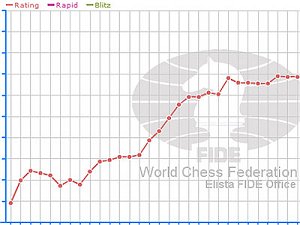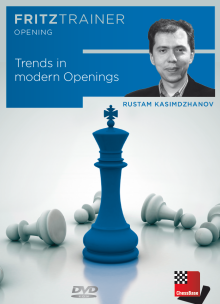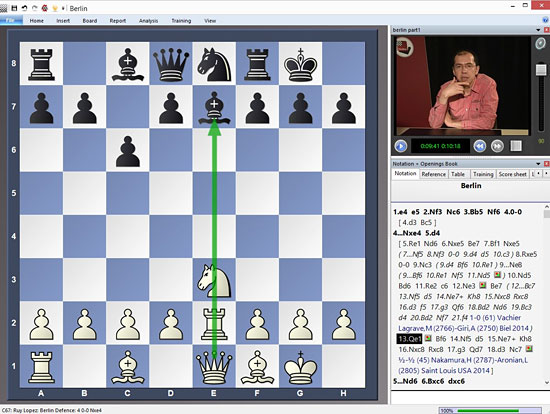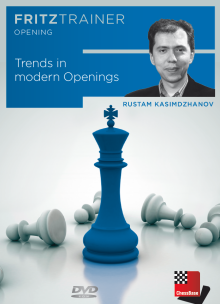


By Carl Portman
“I never see what has been done; I only see what remains to be done”. So said Marie Curie. I take this approach to my chess, and always want to improve, to do more. That should be no different regardless of your level. As a club player I recently decided to try to give my chess a boost as I have had very mixed results in the last twelve months. I decided to study three Chessbase DVD’s, one on the opening, one on the middlegame and the last on the endgame. I spent some 16 hours in the esteemed company of Kasimdzhanov, Sachdev and Müller via the magic of Chessbase DVD’s – technology that I would only have dreamed of as a young man.
I did not select these three DVD’s on any scientific basis but I know that all three commentators are excellent chess players and more importantly very capable of communicating their knowledge in an articulate manner to the viewer. I inserted the first DVD with great anticipation. The pupil was ready, would the teacher appear? Here are my general comments. I don’t profess them to be ‘right’ but they are an objective reflection of my own personal thoughts and feelings.
 Rustam Kasimdzhanov: "Trends in Modern Openings"
Rustam Kasimdzhanov: "Trends in Modern Openings"This has a four hour running time, and consists of 22 Opening videos and 8 test positions.
The first thing I have to be honest about is that I made a mistake. I was looking for something on ideas behind the chess openings and this is not what this DVD is about. It covers trends and recent developments in opening theory. It is not a panacea to improve your game per se but it aims to teach and direct attention to what is occurring in games at the top level. It is of particular value therefore to chess players who are quite advanced in Opening knowledge and want to add the latest ideas to their arsenal.
I was annoyed with my own lack of attention to the detail but decided to carry on with an open mind, knowing that I would learn something. Not all major openings are covered by any means (who could in four hours?) so if you like the Birds or The English or French etc, then you won’t find them here. Kasimdzhanov looks at trends in Openings such as the Sicilian Najdorf, Caro-Kann, Queen’s Gambit Declined, The Scotch, The Berlin Defence the Petroff and more. One line of particular interest to me was the Ruy Lopez with 3…g6. Carlsen played it against Nakamura in St Louis last year and I recall seeing it live on the Internet and being very interested by it. It is a fine example of a current trend, and is becoming one of the major lines.

3…g6 in the Ruy Lopez
There is some complicated material in there such as the Slav with 3…dxc4, something Nakamura has been playing. Kasimdzhanov does a creditable job of explaining his thoughts on such lines but it becomes very clear to me that for club players at least it is simply not enough to learn opening moves by wrote. One must have a clear understanding of why those moves are played and indeed the strategical aims behind them. These are lines from the world’s best remember, and they know what they are doing.
The commentary is rather brisk at times and I found myself having to pause quite a lot to understand the how the position to be analysed was reached. One does have to accept that comments such as ‘White is probably just a little bit better’ are going to be made but there will sometimes be no explanation of why. This happens in books too and I guess only so much can be covered in the time available.
There are plenty of opening trends to look at and if you like those openings, you will no doubt enjoy learning new lines to try at the board, especially if your opening repertoire is not immutable.
The layout, as ever is user friendly and intuitive. I also thoroughly enjoyed the interactive test positions at the end. It is a clever development from Chessbase and ensures that you have the opportunity to put into practice what you have hopefully learned from the DVD.

As I said at the start, this was not the DVD I thought it was, which was my fault for being inattentive but actually I picked up some very useful ideas for my own repertoire which I will look to introduce into my own game when the opportunity arises.
 |
Rustam Kasimdzhanov:
|
Having looked at the opening part of my game I really wanted some middlegame tips as this was an area I have been struggling in. It was therefore time to turn to Tania. Another cup of tea at the ready, DVD loaded – let’s go.
 Tania Sachdev: "FRITZTRAINER Strategy: Improve your chess"
Tania Sachdev: "FRITZTRAINER Strategy: Improve your chess"This has a 4hrs 50 running time with some 15 video sections and 10 Questions/test positions at the end.
Personally speaking the middlegame is the hardest aspect to study. There are so many books and DVD’s on Openings and Endgames but this is very difficult to cover. What IS the middle game? What should I be looking to do? What are the key aspects for forming a plan? Could Tania Sachdev clear those muddy waters for me?
Again, the layout was very clear and for certain parts of the DVD I decided to run the engine alongside the commentary just for fun. Naturally, I do not want to give the whole DVD away but it is important to convey the subject matter covered. Sachdev is clear at the start that the general point of the DVD is to improve middlegame understanding. In bullet point format here are some of the main themes:
Sachdev supports all the points with interesting positions from her own games. And incidentally, she is very honest with those games. They are not sanitised. She occasionally goes down the wrong line (and calmly rectifies this each time) and truly engages the viewer as if she really was opposite you, coaching. I also smiled at the way that she refers to opponents as ‘he’ even where they are female.

The ten quiz questions at the end were very enjoyable to try. Here is an example from the game Tranter – Sachdev, Gibraltar 2013. One is encouraged to find the next move for black which is easy enough, and to find the all-important follow up, which is less easy.

If you work through this DVD diligently, including the test positions you will not fail to learn something new and interesting to employ in your own games. For me, the real moments of clarity were that your plan must improve some aspect of your position – don’t just play moves - and that using small tactics to make strategic gains is the key to success.
This DVD is suitable for players at all levels and I certainly know how to evaluate positions better as a direct result of watching this.
 |
Improve your chess with Tania Sachdevby Tania SachdevFritz Trainer Middlegame Price: €27.90 Order this DVD in the ChessBase Shop |
 Karsten Müller: "FRITZTRAINER Endgames 14: The Golden Guidelines of endgame play"
Karsten Müller: "FRITZTRAINER Endgames 14: The Golden Guidelines of endgame play"This is the fourteenth and last in a series of Karsten Müller’s endgame DVD’s and essentially this one contains elements of all of the previous DVD’s in a condensed form. Clearly the work has been a labour of love. Anyone who has dedicated as much of his life to one subject as Herr Müller deserves respect. He began this journey in 2006. That said, it is said that what is written (or recorded) without effort is generally read (or observed) without pleasure. Thus, the fact that someone expends such time and effort into something does not in itself make it any good. Therefore, I was keen to rip off the cellophane wrapping and get on with the viewing so as to make my own mind up.
Considering that this DVD is some 7½ hours in length I was wondering if I might just get bored. The endgame is the third aspect of my game that I wanted to learn something new about and I knew that there would be hidden gems in this DVD. I was not to be disappointed.
The work is in two parts, each with sub-divided subject matter. Part one consists of General Rules of Thumb (e.g. activate the king) and part two sets out the Special Endgame principles. Müller tells us that these are the golden guidelines of endgame play. The layout again is very clear and the ability to pause and reflect is always useful.
He begins by imparting great wisdom and something that he will reinforce throughout the whole DVD. He warns us in an almost fatherly manner that simply following guidelines automatically is a mistake and that there is no substitute for concrete calculation. As you go through the DVD, you become ever more aware of this.
Some of the themes of part one include the correct exchanges, weaknesses, thinking methods and the rule of the square. The section about not exchanging your active pieces was most useful. Part two includes all of the main endgame themes with pieces pawns, rooks queens and the like but I was particularly fascinated with the sections on fortresses, Zugswang, the Opposition and Bähr’s rule. (Have you heard of this?)
Very topical in recent online commentary at top tournaments has been the Lucena and Vancura positions and these are covered very articulately also. It looks so easy when Der Meister takes you through it.
Using the King in the endgame is something we don’t do enough of at club level and we are given one very interesting position where the viewer is asked what they would play. Well, the point was to activate the king and the following screenshot (See figure) shows how this might be done and what to look for on the board.

There really are some priceless gems here that we can return to time and again. Even something I already know, like the rule of the square is shown in such a way that I can now employ it quickly at the board to replace time consuming square calculation. (Though I am clear that guidelines do not replace concrete calculation, as you say Mr Müller!)
It never occurred to me before that, for example in a king and rook v lone king endgame there always has to be a Zugswang before checkmate. Of course there does! I just never thought about it like that and it is a good way to coach Zugswang to juniors.
One of my favourite pieces refers to being flexible and the Walter-Alexander game illustrated this beautifully. Look at the position.

Many of us would naturally put our black rook on a6 to prevent the march of the pawn, but this is a mistake. You’ll need to see the DVD to ascertain why and what to do instead but this is another example of how you can easily learn something very important, very quickly to take into your own game. In fairness there are times when Mr. Müller jogs on a little typical’ but some things are not so typical to us all so it is good to recap.
Karsten Müller is an expert on the endgame, it is as simple as that. What he doesn’t know about endgames isn’t worth throwing into a cold bath. He clearly loves his chess, and his sheer delight at some of the problems manifests itself in the broad smiles he conveys to the viewer. His enthusiasm is infectious and whilst initially he can appear to be a tad serious he soon employs that childlike curiosity of the Royal Game which is enough to convince any viewer that he is just the right man for the job. He seems to want you to love it as much as he does. Dostoevsky wrote that “All the utopias will come to pass only when we grow wings and all people are changed into angels”. Karsten Müller gave me wings! He is excellent (as is his command of the English language) and the material he has chosen to share is first class. You won’t fail to learn from this DVD and I congratulate him now that he is at the end of his journey.
 |
Karsten Müller: Chess Endgames 14
|
To conclude: I began my own journey by selecting three DVD’s on each of the phases of the game to boost/refresh my own chess approach. Even though I selected the ‘wrong’ Opening DVD it is still a very good offering for those wishing to examine current trends and stay abreast of recent developments. The Middlegame and endgame DVD’s gave me the most pleasure and reinforced what I knew at the age of 12, that chess is a magnificent game, one of art and beauty and indeed science. I had almost forgotten how uplifting it is to dive into the ocean of the endgame and seach for pearls.
All three DVD’s delivered what they said they would on the cover. After studying them I felt compelled to get out and play chess which is exactly how it should be. Now that Kasimdzhanov, Sachdev and Müller have left I feel somewhat deflated but I let them go with a full heart and my grateful thanks.